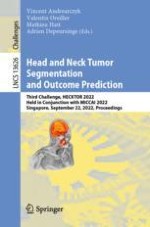2023 | Book
Head and Neck Tumor Segmentation and Outcome Prediction
Third Challenge, HECKTOR 2022, Held in Conjunction with MICCAI 2022, Singapore, September 22, 2022, Proceedings
Editors: Vincent Andrearczyk, Valentin Oreiller, Mathieu Hatt, Adrien Depeursinge
Publisher: Springer Nature Switzerland
Book Series : Lecture Notes in Computer Science
